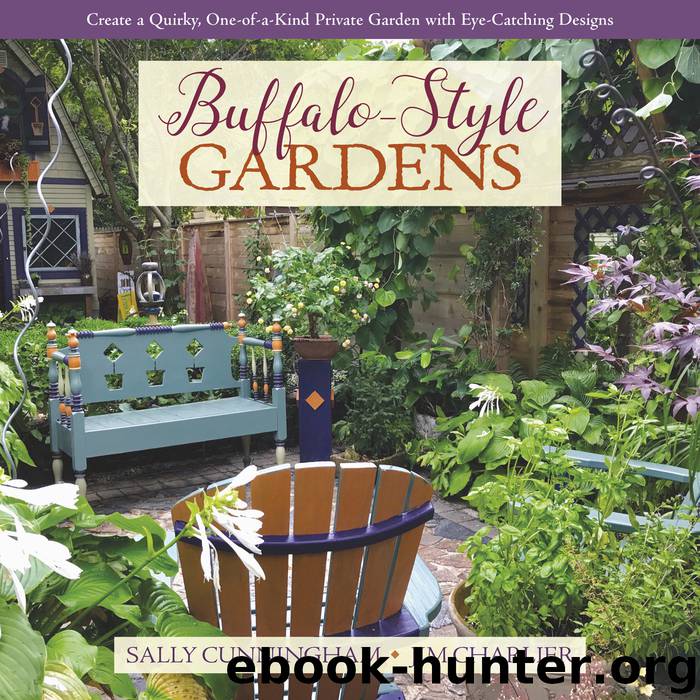Buffalo-Style Gardens by Sally Cunningham

Author:Sally Cunningham
Language: eng
Format: epub
Publisher: St. Lynn's Press
Published: 2019-03-20T16:00:00+00:00
What bones go where?
Earlier, when we talked about basic design principles, we mentioned important elements such as balance, proportion, rhythm and emphasis. These are all key to figuring out where to place large pieces in your garden, or to analyze what’s not working in the design you have.
Some of the guidelines for what goes where are common sense. You know what’s right when you see it, especially when it comes to balance and proportion. Think about your living room: Unless you have no other choices about the furniture arrangement, you probably won’t put a large sofa, massive mahogany bookshelf, and Grandpa’s oak desk on one side of the room and on the other side three Victorian ladies’ side chairs and a delicate lamp table. The balance is off. You also probably wouldn’t like seeing a solid 6 x 4-foot credenza in the baby’s room next to the tiny crib and layette. The proportion is off.
Other times it’s not so obvious what to do in an outdoor space. Some of us (Sally included) have to learn some principles from professional designers, such as the following:
Visual weight and size are two different things. When you’re planning a focal point, consider more than its height.
A tall Tamarix tetrandra (Tamarisk) in a standard (a single-trunk tree shape) might measure 10 feet tall and 3 feet wide. With wispy pink flowers on delicate branches it has a much lighter feeling than the same sized evergreen such as a ‘Skyrocket’ juniper or a ‘Sky Pencil’ holly. If you put a tall evergreen, say, on one side of a front porch, the Tamarix would not have enough visual weight to balance the evergreen. To balance the tall juniper, you could still use the Tamarix, but you’d need to surround it with a group of Chamaecyparis (false cypress) or 4-foot dark-leaved hollies to get the density or visual weight.
For balance, you don’t need symmetrical plants or same-sized plants. (That gets boring quickly.) You do need to balance density or visual weight.
What gives a plant density or weight? In the balancing act that is part of design, look at dark leaves (green, wine-colored, or bronze) and large leaves as clues to visual weight or density. Structure also counts: Crowded branches or tightly packed needles add to the solid feeling of a plant, and tightly mounded shrubs appear heavy.
The practical application:
When you’re looking out at the garden from the window, or facing the front yard from the street, you’ll be most pleased – consciously or unconsciously – if the scene feels balanced. Remember that living room: The heavy, big pieces can’t all be on one side.
Download
This site does not store any files on its server. We only index and link to content provided by other sites. Please contact the content providers to delete copyright contents if any and email us, we'll remove relevant links or contents immediately.
| Container Gardening | Hydroponics |
| Organic | Propagation & Cultivation |
| Topiary | Urban |
| Water Gardens & Ponds |
Turbulence by E. J. Noyes(7039)
The Thirst by Nesbo Jo(5785)
Gerald's Game by Stephen King(3918)
Be in a Treehouse by Pete Nelson(3212)
Marijuana Grower's Handbook by Ed Rosenthal(3118)
The Sprouting Book by Ann Wigmore(3052)
The Red Files by Lee Winter(2914)
The Remains of the Day by Kazuo Ishiguro(2618)
Sharp Objects: A Novel by Gillian Flynn(2445)
Christian (The Protectors Book 1) by L. Ann Marie(2394)
Organic Mushroom Farming and Mycoremediation by Tradd Cotter(2307)
The Culinary Herbal by Susan Belsinger(2061)
Stone Building by Kevin Gardner(1995)
The Starter Garden Handbook by Alice Mary Alvrez(1924)
Lilac Girls by Martha Hall Kelly(1872)
The Unlikely Pilgrimage of Harold Fry by Rachel Joyce(1836)
The Lean Farm Guide to Growing Vegetables: More In-Depth Lean Techniques for Efficient Organic Production by Ben Hartman(1784)
Urban Farming by Thomas Fox(1749)
Backyard Woodland by Josh VanBrakle(1587)
